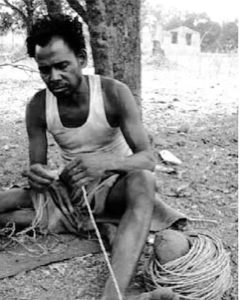
The Birhor move freely between their identities as foragers, hunters, and active business people, allowing them to survive in a world where they are frequently marginalized by government officials and a Hindu majority. Having studied the Birhor extensively, author Deborah Nadal was intrigued by their ability to fluidly navigate these identities. She explores this aspect of their culture in her paper, “Hunting Monkeys and Gathering Identities: Exploring Self-Representation among the Birhor of Central-East India.” (2014)
The Birhor, whose name translates to “man of the forest,” are proud of their forest-dwelling identity, which also serves to distinguish them from other groups. In fact, according to Birhor folklore, their most important ancestral figure was the first person to survive in the forest and learn to collect siali (Bauhinia vahlii), the fibers used to make hunting nets and ropes. As Nadal later discusses, siali products are integral to Birhor culture.
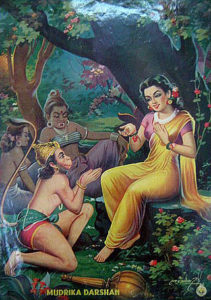
Neighboring communities refer to the Birhor as Mankria, a reference to “those who eat monkeys.” Unfortunately, this title is not taken lightly by Hindus who revere the monkey-god Hanuman. So while the Birhor are proud of their expertise at hunting monkeys, there is often a high degree of social stigmatization as a result. As Nadal explains, “it is not surprising that the relationship between Birhor and monkeys is extremely delicate, ambivalent and in a continuous process of re-negotiation. After all, this negotiation represents the essence of a broader matter which has fundamental consequences both at social and economic levels.” (p. 266)
Birhor pride in hunting monkeys is so deeply rooted that their version of the ancient Hindu poem, the Ramayana, describes Hanuman as the very god that taught them how to capture monkeys so effectively. The story tells how Hanuman took pity on the Birhor and told them how to improve their nets so they could capture him, and they did. The species of monkeys that are hunted may vary, but those of greatest significance are the Grey langur or Hanuman langur, Presbytis (Semnopithecus) entellus, and the Rhesus macaque, Macaca mulatta.
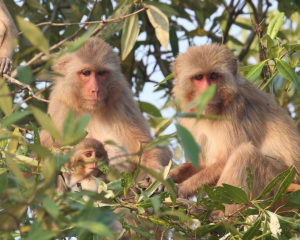
To non-Birhor, eating monkey meat is even more deplorable than killing them. Nadal points out that some Birhor communities have no problem eating it while others say monkey flesh is taboo. She interprets this as an attempt to build a better image with Hindu neighbors rather than a lack of access to forests and monkeys, as some Birhor have explained it. Monkey meat is not sold at market since there is no demand for it. However, live monkeys are sold as pets and to traders who then sell them to research laboratories. Monkey hides are sold to other Birhor for making drums.
Nadal also describes how the Birhor’s identity as hunters has created a reputation as having both the physical and behavioral prowess of monkeys. In fact, their skills are hardly ignored by agriculturalist neighbors in Odisha who hire them to remove crop-raiding monkeys. Such skillful hunting heightens the ambiguity surrounding them, with rumors of their ability to charm animals into traps or catch them using supernatural powers. The Birhor, who are well aware of how others perceive them, may, at times, use this to their advantage by working as diviners, sorcerers, or medicine men.
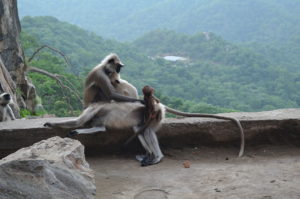
While many Hindus are not happy with some Birhor practices, there is still a healthy amount of respect for them since forests, in Hindu imagery and Vedic literature, are associated with the unknown, demonic or celestial beings, and ascetics. Thus, the Birhor image as people of the forest helps to create a shroud of mystery around them, and allows the freedom to re-shape their identities as needed.
In addition to hunting, the Birhor are also foragers, collecting honey, fruits, flowers, and siali fibers for rope making and related products. It is this latter resource that is most sought after at local markets. Their ropes, and especially nets made from them, are another key component of Birhor identity for three reasons: the Birhor are the only group in the area that use nets for hunting; nets are the most effective means of hunting monkeys, their preferred prey; and finally, they are proud of the their ability to harvest the creeper, Bauhinia vahlii, for siali fibers.
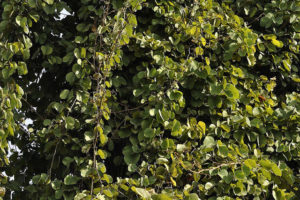
Nadal goes into great detail describing Birhor net making and monkey hunting, making this article an excellent resource on their subsistence strategies. She also points out an interesting contrast in hunting techniques between Birhor groups. The Odisha Birhor use nets and hunt monkeys, whereas the Jharkhand Birhor use bows and arrows and do not hunt monkeys. In fact, the Odisha Birhor will not capture a monkey accidentally hit by an arrow. The reason for this is that the bow and arrow are seen as unnecessarily violent and create such a high degree of suffering that it reduces the quality of the meat. It is interesting to note that Jharkhand Birhor are the same group that shun eating monkey meat in an attempt to gain higher status amongst neighboring Hindus.
Nadal does touch on the widespread governmental regulations affecting the Birhor since the 1950’s. Up until this time most of the Birhor were nomadic and lived on the products of their hunting and the selling of handicrafts. However, since that time, vast cultural and economic changes have occurred. The establishment of national parks not only limited their access to lands on which to hunt, but also resulted in the forced resettlement of many Birhor. Moreover, in areas where they did have access to forest resources, not only was hunting banned, but often lumber and bark products were off limits as well.
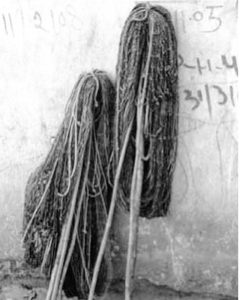
Thus, the Birhor are left with drastically reduced natural resources and have been forced to search for alternatives. However, this does not mean they are willing to abandon their traditional practices. They still hunt when possible and are very capable of “combining old customs with the new conditions.” (p.273) For example, when nets of natural fibers are in need of repair, they may use readily available plastic threads from commercial packaging instead.
As their world changes around them, so then do the Birhor, but often on their own terms as they maintain, if only symbolically, their traditional practices. Ultimately, the story Nadal wishes to tell, unlike the tragic tales of their decline, is one of their flexibility as nomadic hunters and gatherers. She not only succeeds in doing this, but also provides us with an image of the Birhor as active agents in shaping their own future and identities.
Nadal, Deborah. 2014. “Hunting Monkeys and Gathering Identities: Exploring Self-Representation among the Birhor of Central-East India.” La Rivista Folklorica 69:263-278
By Sherrie Alexander, University of Alabama at Birmingham